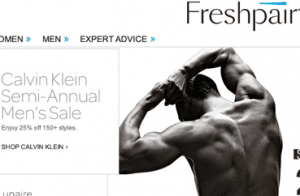 You have to be confident to be a superhero, right? And what do two of the best classic superheros, Batman and Superman, have in common? They wear their underwear on the outside of their costumes.
You have to be confident to be a superhero, right? And what do two of the best classic superheros, Batman and Superman, have in common? They wear their underwear on the outside of their costumes.
Maybe that’s what underwear etailer Freshpair had in mind when it coined its tagline “your confidence is showing.”
“Confidence can, of course, start with your underwear—it’s an intimate thing about you that in many cases only you know about, and we want to take that inner confidence and bring it outward,” says Jason Scoggins, director of customer experience.
Scoggins joined Freshpair three years ago from Southwest Airlines, where he ran all of its promotional email programs. A robust email program targeting nine core segments is a key marketing component in making Freshpair feel confident about reaching a decidedly diverse customer base, covering everyone from folks simply looking for utilitarian undergarments to fashionistas racing for the latest styles and everyone in between.
Like so many other dot-com startups, Freshpair began on a college campus, where an enterprising student had the idea to set up a campus underwear delivery service. The website Freshpair.com was launched in 2001.
Freshpair’s customer base is split 50/50 between men and women. Customers buy for variety of reasons, says Scoggins. Some are in small towns and don’t have local access to the products they want, while others are truly passionate about underwear as a fashion item and want the newest styles.
“My goal is to speak to each of those customers as directly as possible,” says Scoggins. “Once we know who someone is, we speak to them in a way that is as tailored as we can get.”
STYLE SEGMENTS
On the women’s side, there are four segments—Sophisticated (buys at a higher price point than average and interested in less coverage), Contemporary (younger, wants to stay on trend without spending a lot), Classic (wants high quality and conservative styling that is still on trend) and Legacy (has worn the same brands for years and sees Freshpair as a go-to place for brands like Bali or Vanity Fair).
On the men’s side, the four core segments are Designer (likes name brands and high quality), Bold (contemporary and in fashion, always buying latest colors and styles), Thrill (likes more risqué styles that push the limits) and Classic (like their female counterpart, knows what they want and sticks to longstanding brands like Hanes or Fruit of the Loom).
The ninth customer segment, and perhaps the most difficult to target, is the Unknown. This is someone who has just joined the email file and hasn’t made a purchase yet, so Freshpair isn’t sure how to speak to them.
“We do a lot of progressive profiling, and embed a lot of our links,” says Scoggins. “We primarily need to figure out whether someone is shopping on the men’s or women’s side of the house.”
Freshpair asks this important question in the first welcome email, and of course, some shoppers click “both,” meaning it can take a while before they see the real interests of a shopper. “Someone who is female might only be purchasing for a man in her household, so she might belong in the classic men’s segment,” Scoggins explains.
While shoppers in one of the eight men’s or women’s segments get more targeted messaging, the Unknowns get emails that focus on specials or deals on a weekly basis. In the past, Freshpair targeted the entire list with three or four emails each week on a variety of topics. The company decided to test what would happen if those emails were rolled up into one and then sent twice a week, on the days with the highest response.
The result was higher open and click-thru rates, so The Brief was born. The Brief delivers all of Freshpair’s “news” for the week in one concise email, which goes out on Sunday and then again later in the week. All the email modules are dynamic, so everyone can get a different creative targeted to their interests. Sometimes the differences might be as simple as a different treatment of the imagery, while other times it might be a different story or tone of messaging.
For example, a recent article on a new product from Wacoal was appropriate for different segments. For the Classic segment, the model wearing the item was shown in close-up, to showcase the product. For the Sophisticated segment, the creative zoomed out on the shot, to show the model’s entire look with stockings and heels, to make it look more high fashion.
GETTING CREATIVE
When the second weekly email of The Brief goes out, the subject line is tweaked and inside creative may be changed depending on what performed well in the Sunday mailing. Male audiences typically like the “cheekier” subject lines, particularly in the Bold and Thrill segments, while women respond better to straightforward messaging.
“It’s a challenge for the copywriters to switch gears but it can be fun,” Scoggins says.
A “Warning: Graphic” subject line to the Thrill segment had one of the company’s highest open rates ever. With content like this, deliverability was a big concern. “That was my biggest fear but thankfully it hasn’t proven to be a problem for us,” he notes.
Freshpair has worked with Responsys on its email marketing program for about four years. One of the big challenges is figuring out the customer lifecycle—what do they want to buy and when will they want to buy it again? “We’ve got all these different segments, and can’t just say a male customer will buy from us every month and a woman will buy X times a month,” says Scoggins
“We have do dive in and figure it out at a customer level, which is a challenge for all retailers,” he notes. “We’re an underwear company, we’re not Macy’s so we don’t have 100 different verticals we can push. We have a limited story to tell. The challenge is getting to know the customer well enough—it’s all about timing.”
This is, of course, where weekly emails come into play, to stay top of mind with the customer base, even when they are not in buying mode, but the need to create new value propositions is continuous.
With this in mind, the company launched a subscription service about 18 months ago. The customer can opt-in to get the same products every three or six months (or whatever frequency they choose). “It’s really helped us create an additional data point as we fine-tune those lifecycle moments. If you’re a tighty-whitey guy, you know you need to replenish every X number of months, but women need more education about the lifespan of a bra and when you should replace them.”
Freshpair looks at engagement, open rates and response rates when considering the ROI of its email initiatives. “We know for a fact our customer isn’t always in a buying cycle, so if we can keep them engaged in the off periods, that’s important,” he says, noting open rates average in the 20% range, while response rates are typically 5-50%. Trigger messages can hit into the 50% range, depending on relevancy.
The company also does a lot of social media tie-ins with email, to reach fans who want to become more involved with the brand. In-house fit specialist Bobbie Smith (known as “Ms. Fit”), who does over-the-phone bra fittings with customers, is also being featured in social media and email, to showcase the brand’s expertise in outfitting customers in the right underwear for their shape and comfort.
It’s a great opportunity to take all the wonder content we’ve had on the social side and use it across all our channels to give extra insight in what customers are passionate about,” says Scoggins.
One event the company heavily promoted via social channels was National Underwear Day on Aug. 5. The company created the “holiday” to promote the idea of people feeling confident in their skivvies. This year, about 1,000 people attended the event in Times Square—the only requirement was that you had to be in your underwear.
 Network
Network

